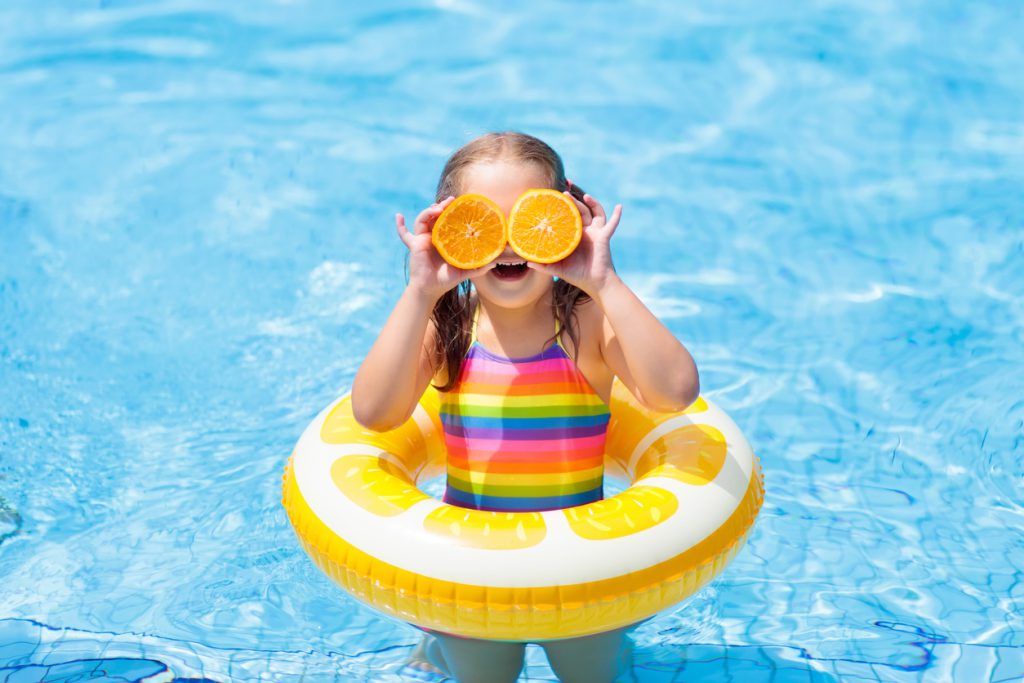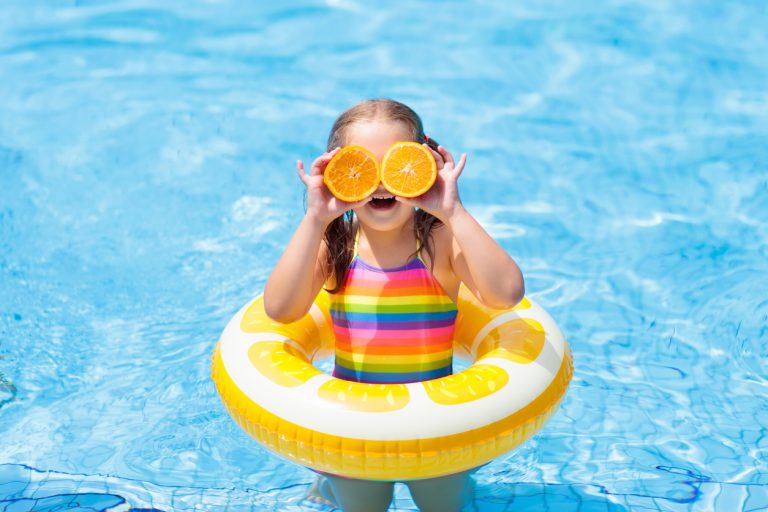Originally published in the Summer 2023 issue of Kansas Child Magazine.
Summer is here! We love the sunny days and the freedom that a break from school can bring. While summer break means less rigid and hectic schedules for some, research shows that many children are less physically active in the summer months than during the school year.

Benefits of Physical Activity
You may remember childhood summers filled with activities like riding bikes, walking to the local swimming pool, or playing games with friends. However, for many children today, these types of active summer experiences have become less common.
Regular physical activity helps all of us feel and function better. Being physically active reduces the risk of many chronic diseases and improves sleep quality and mental well-being. Evidence also shows that starting physical activity early helps children develop their gross and fine motor skills, expend energy, and improve their mental health.
Children that develop these healthy habits in their youth are more likely to become active adults. Making physical activity fun ensures that your kids will enjoy the benefits of being active throughout their lives.
How Much Activity is Enough?
Kids should be active every day. Recommendations for the types of activity and level of intensity vary based on the child’s age and stage of development.
- Babies, from birth to 12 months old, should be placed in safe environments that stimulate exploratory movement through unstructured active play several times a day.
- Both toddlers (12 to 36 months) and preschoolers (3 to 5 years) should engage in at least 60 minutes, and up to several hours, of unstructured physical activity each day. Kids at this age should not be sedentary for more than 60 minutes at a time, except when sleeping.
Below are some ways to keep kids active this summer and prevent the dreaded complaint: “I’m bored.”
Be Active Every Day
Here’s what that can look like:
- For babies, parents can facilitate play that encourages kicking, grabbing, and pulling.
- Babies can explore movement during 30 minutes of tummy time.
- Parents with toddlers and preschoolers can engage in play that encourages catching, throwing, hopping, skipping, and kicking.
- Families can visit a neighborhood park and/or
- Families can take a walk around the neighborhood.
- Young children can start exploring youth sport opportunities like soccer, swimming, and tumbling.
Get the Kids Involved
As you’re deciding how to incorporate more physical activity this summer, hold a family brainstorming session. Ask the kids to think of activities they would enjoy that fit into the household routine. That way you’ll be prepared with some go-to physical activity ideas as alternatives to screen time and boredom. Children are usually more likely to try an idea that they came up with themselves.
Make a Bucket List
After the brainstorming session, create a summer “bucket list” of activities. Keep the list visible so it’s easy to use to come up with things to do on a daily basis. Check off fun activities from the list as you do them. See the sidebar for some ideas to include on your bucket list.
Model Physical Activity
Parents are role models. They can set a positive example by modeling healthy lifestyle behaviors. Here are a few ideas for how to build activity into your own routine.
- Park at the back of the parking lot to get extra steps on the way to the grocery store.
- Walk or bike to a nearby park or playground or around the neighborhood after dinner.
Set Screen Limits
This could mean turning off all screens one hour before bedtime or requiring an hour of outdoor playtime before turning on a screen. You can also try creating screen-free zones in the house. TVs and devices should stay out of the bedroom.
Play as a Family
Schedule a family game night once a week, with a different family member choosing what to play each time. Games can be indoors or outdoors — anything from cards or board games to tag or hopscotch. Think back to outdoor games you enjoyed playing as a kid, like hide-and-seek, freeze dance, jump rope, or capture the flag.
Ideas for Your Summer Bucket List
Find a new park
Check out area trails, parks, playgrounds, or green spaces this summer. Many city or county parks and recreation department websites list local parks and playgrounds, trails, or other activities. Look for a park near you, or venture to one farther away with features your kids might enjoy, like jungle gyms or outdoor splash pools. If you are in the Kansas City area, KC Parks has a searchable function by age group and features (ex. playgrounds, pools, and hiking trails) to help you find just what you are looking for. You can also find a Kansas State Park to explore by visiting the Kansas Department of Wildlife and Parks website.
Hop on a bike
Family bike rides around the neighborhood can be a fun summer activity. Try swapping a car ride with a bike ride to a nearby destination. If you are new to riding a bike, BikeWalkKC Youth Education Resources offers great ways to get started. The Kansas Cyclist website is also a great resource for trail systems across the state. When you head out on the trail, make sure you wear a snug-fitting helmet and obey safety guidelines!
Take a hike
Kids are often invigorated by a change of scenery. Getoutdoorskansas.org has an interactive map of trails across the state that are open to the public. Don’t limit yourself by sticking only to your neighborhood. There are many streams, lakes, wooded areas, grasslands, campgrounds, fishing spots, and outdoor playgrounds to explore!
Beat the heat
From spray parks to lakes, Kansas has a lot of active water play to offer. Most spray parks or splash pads are run by county or city parks and recreation departments and are free to use. Some county lakes have canoes, kayaks, and even paddleboards for rent. Remember to bring age-appropriate floatation devices when taking kids near water. Ensure that kids feel safe around water by signing up for swim lessons, which teach an essential lifelong skill. Lessons can be found at community centers or YMCAs or through your city pool or local parks and recreation programs. Don’t forget the sunscreen!
Walk it out
Walking as a family can be a great activity to add to your routine in the summer. Not only do you get some precious family time, you’ll also experience physical and mental health benefits. Although walking doesn’t require equipment, not everyone lives in a neighborhood that feels easy or safe to walk or bike in. Everyone deserves the chance to be healthy and active, and research shows that when a neighborhood has safe nearby parks, trails, playgrounds, sidewalks, and bike lanes, children and families are more likely to be active.
Join an organized youth program
Many city parks and recreation programs, community centers, dance studios, and gymnastic programs offer an introduction to youth sports. These programs provide structured lessons that teach kids the fundamentals of a sport while also helping them develop the mechanical skills they’ll need to participate in sports throughout their lives. These opportunities allow kids to try out a variety of opportunities without being overly competitive.
Stay active indoors
Getting outdoors in the summer is wonderful, but Kansas summers can have extreme heat waves and summer storms that prevent outdoor activities. There are still ways to stay active when you need to spend the day indoors, however. The Fit-Tastic! and Sesame Workshop websites offer a wide variety of engaging activities that children under five can try out at home.
-

Natalie Updyke
Research Associate, Kansas City Healthy Lifestyles Collaborative
In her current role, Natalie supports the Kansas City Physical Activity Plan, a regional plan whose vision is to build a culture of physically active lifestyles throughout Kansas City for all residents. She also contributes to ongoing community health and wellness research projects and promotes the community health behavior campaign, 12345 Fit-Tastic!
-

Shelly Summar
Kansas City Healthy Lifestyles Collaborative Program Manager, Children’s Mercy Kansas City Center for Children’s Healthy Lifestyles and Nutrition
Shelly is a registered dietitian with over 30 years of experience treating children and families for nutrition-related issues. She also completed a certificate of training in childhood and adolescent weight management through the Academy of Nutrition and Dietetics and participated in the Healthy Communities Leadership Academy through the Health Forward Foundation.






